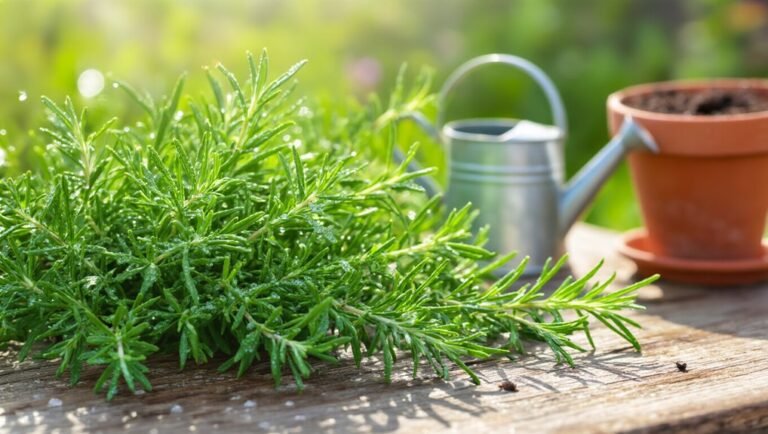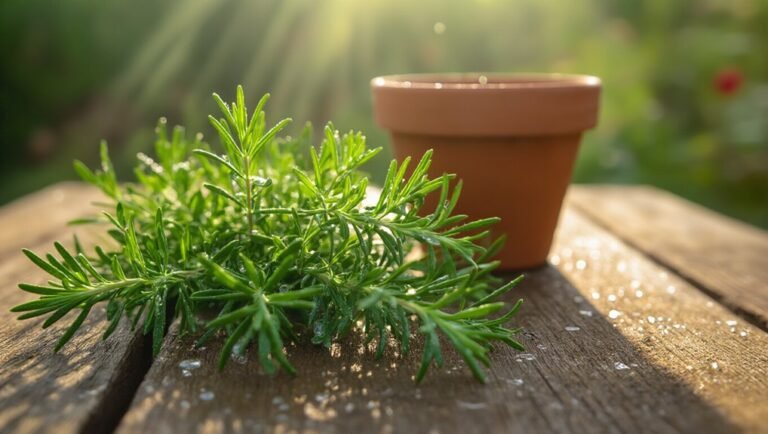To harvest rosemary correctly, wait until just before the plant flowers in late spring or early summer for the best flavor. Use sharp shears to cut healthy stems at least 6 inches long, just above a leaf node. Always prune in the morning when the oils are concentrated. Regular harvesting promotes new growth. Remember to store any fresh cuttings properly for longevity. If you want to learn more about maximizing your harvest, keep going!
Key Takeaways
- Harvest rosemary just before flowering in late spring or early summer for the best flavor and aroma.
- Use sharp garden shears or scissors to make clean cuts, avoiding damage to the plant.
- Cut stems at least 6 inches long above a leaf node to encourage new growth.
- Regularly prune the plant every few weeks to promote bushiness and higher yield.
- Dry harvested rosemary by hanging it upside down in a dark, cool place or using a dehydrator.
Understanding the Growth Cycle of Rosemary
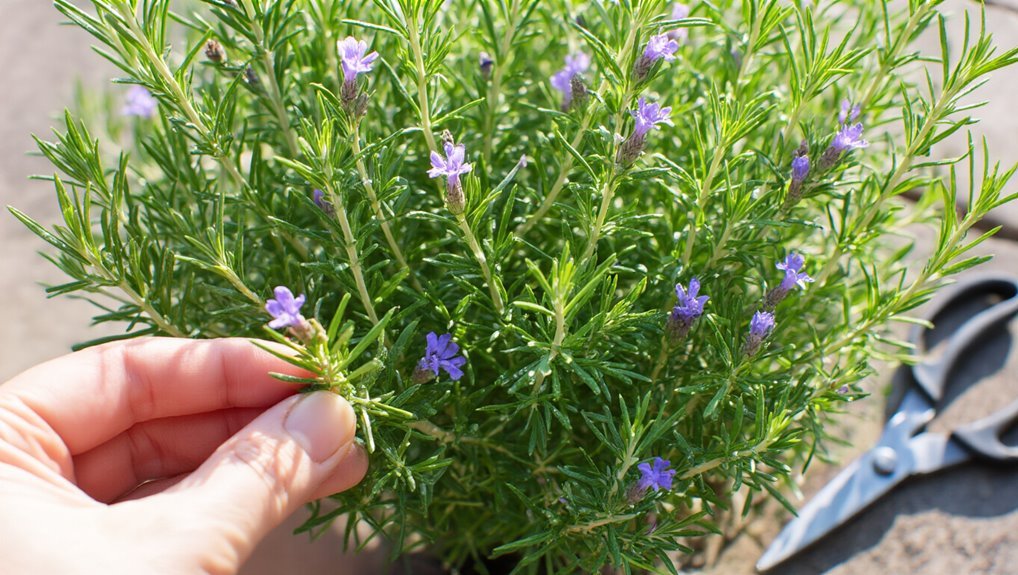
Understanding the growth cycle of rosemary is essential for timing your harvest just right. This perennial herb thrives in well-drained soil and plenty of sunlight. When you first plant rosemary, it typically takes a few weeks to establish roots. During the growing season, which usually runs from spring to early fall, you’ll notice rapid growth. If you want to simplify the process, herb garden kits with seeds and pots make it easy to get started with rosemary and other culinary herbs. As the plant matures, it develops woody stems and lush foliage, indicating it’s ready for harvesting. You’ll want to keep an eye out for the flowers, as they signal the end of the growth cycle. Regular pruning encourages new growth and enhances flavor, so don’t hesitate to trim back your rosemary throughout the season. By understanding these cycles, you’ll ensure a bountiful harvest.
If you’re starting your rosemary from seed, using seed starting kits can help ensure strong and healthy seedlings that are ready for transplanting outdoors.
The Best Time to Harvest Rosemary

While you can harvest rosemary at various stages of its growth, timing it right can significantly enhance the flavor and aroma of the herb. The best time to harvest is just before the plant flowers, typically in late spring or early summer. At this stage, the leaves are most fragrant and flavorful. Early morning is ideal since the oils are concentrated after the night’s cooler temperatures. Many gardeners grow rosemary as part of indoor herb gardens, which makes it easy to control harvesting times and conditions.
Here’s a quick guide:
| Time of Year | Ideal Conditions |
|---|---|
| Late Spring | Before flowering |
| Early Summer | Morning hours |
| Late Summer | After flowering starts |
| Fall | Harvest sparingly |
For more tips on growing and caring for herbs, consider exploring Gardening books that provide expert advice and in-depth knowledge.
Tools You’ll Need for Harvesting
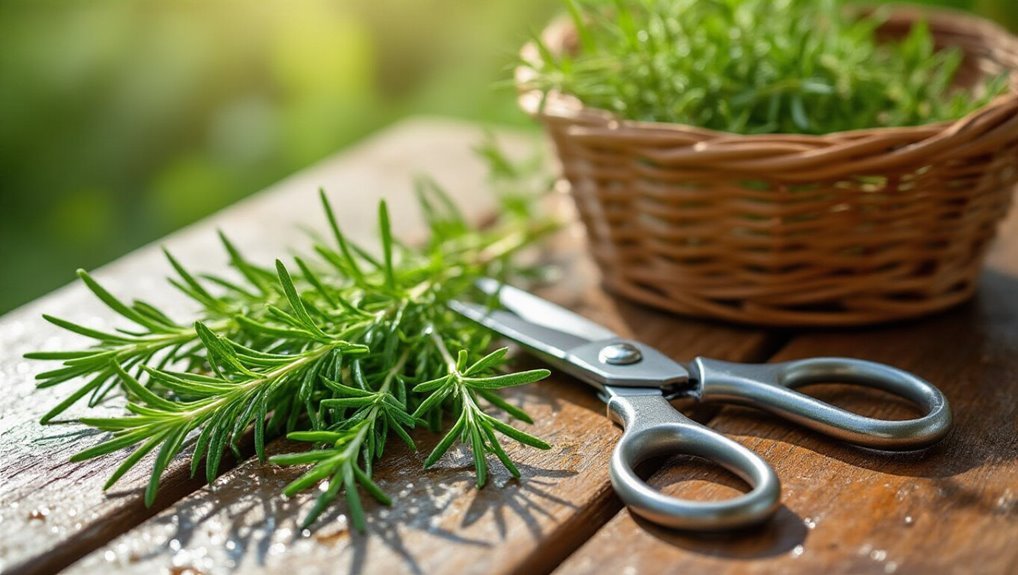
To successfully harvest rosemary, you’ll need a few essential tools that make the process easier and more efficient.
Start with sharp garden shears or scissors; they’ll help you cut stems cleanly without damaging the plant. Many gardening tool sets include quality shears and scissors, making it easy to have the right equipment on hand. A pair of gloves is also useful to protect your hands from any prickly parts of the plant.
Consider using a basket or cloth bag to collect your cuttings, keeping them organized and preventing damage. It’s also handy to have a small container of water nearby to place your freshly cut stems, preserving their freshness until you’re ready to use them.
With these tools in hand, you’ll be well-prepared to enjoy a bountiful harvest of rosemary! For the cleanest cuts and healthiest plants, consider investing in pruning shears, which are designed specifically for gardening tasks like harvesting herbs.
How to Cut Rosemary Stems Properly
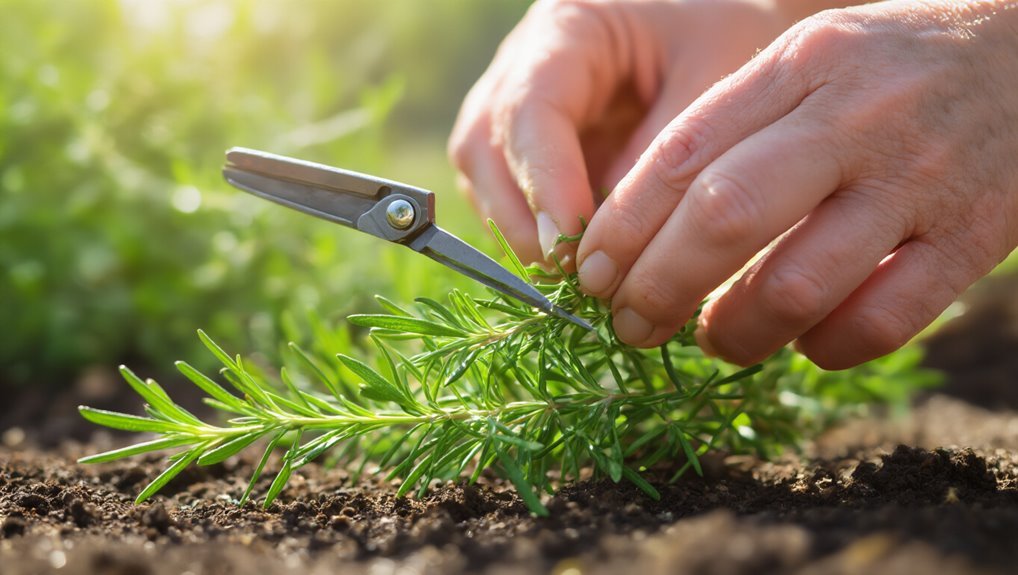
Start by selecting healthy, robust rosemary stems for cutting, as they contain the most flavor and essential oils. To cut the stems properly, use sharp kitchen scissors or pruning shears to avoid crushing the plant. Look for stems that are at least 6 inches long, and cut just above a leaf node to encourage new growth. Aim to harvest in the morning when the oils are most concentrated. For gardeners interested in maximizing their harvest, using hand rakes can help tidy up the soil and make access to your rosemary plants easier. Selecting the right watering cans is also beneficial, as consistent moisture helps rosemary stay healthy and produce more flavorful stems.
Here’s a quick reference table to help you:
| Step | Description | Tips |
|---|---|---|
| Select Stems | Choose healthy, robust stems | Look for rich color |
| Cut Technique | Use sharp scissors or shears | Avoid crushing the stem |
| Length | Aim for 6 inches or longer | Check for leaf nodes |
| Timing | Harvest in the morning | Oils are more concentrated |
| Encourage Growth | Cut just above leaf nodes | Promotes new shoots |
Techniques for Maximizing Your Harvest
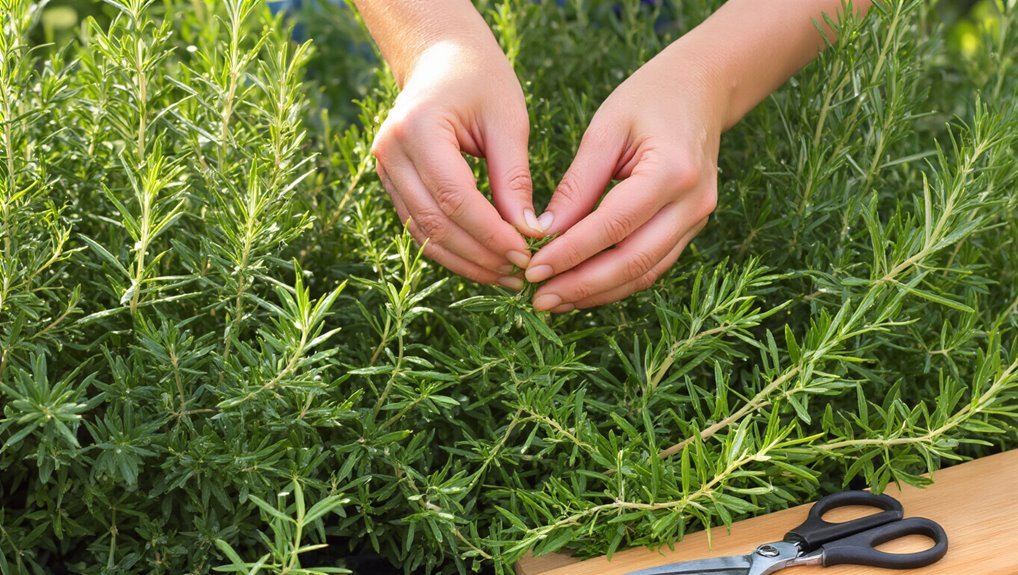
After you’ve cut your rosemary stems correctly, maximizing your harvest can significantly enhance your yield.
To ensure you get the most out of your plants, consider these techniques:
- Regular Pruning: Trim your rosemary every few weeks to encourage growth. This helps keep the plant bushy and productive. For added benefits, consider applying organic mulching materials around the base of your rosemary to suppress weeds and boost soil health.
- Optimal Timing: Harvest in the morning when the essential oils are most concentrated. This not only boosts flavor but also increases the overall potency of your rosemary.
- Watering Wisely: Ensure your plants are well-hydrated but not overwatered. A consistent watering schedule promotes healthy growth, leading to a more abundant harvest.
Using mulch in your garden can also help retain soil moisture and regulate temperature, which supports the overall health and productivity of your rosemary plants.
Storing Fresh Rosemary for Longevity
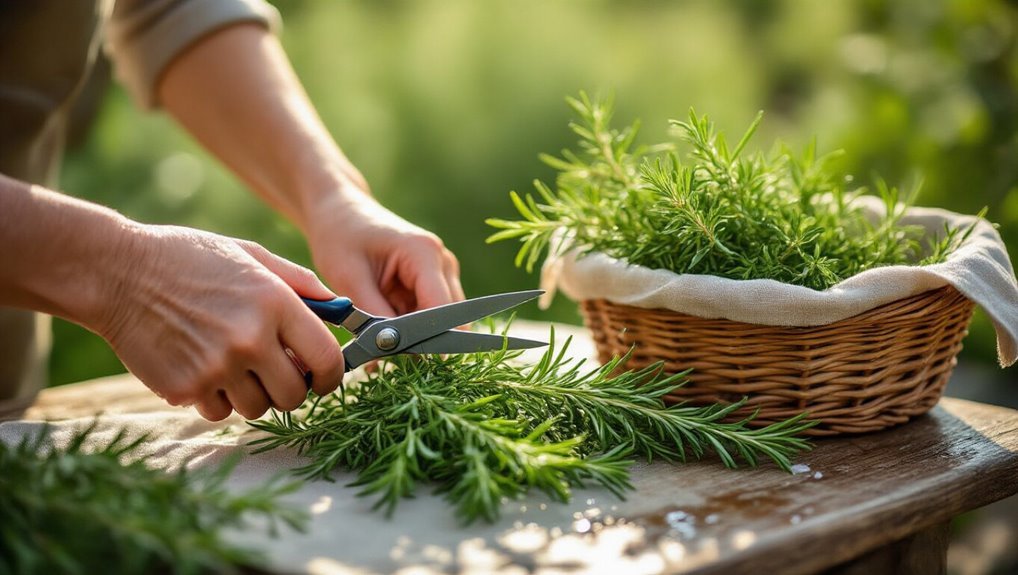
Although fresh rosemary adds vibrant flavor to your dishes, knowing how to store it properly can extend its shelf life significantly. To keep your rosemary fresh, try these methods:
| Storage Method | Description |
|---|---|
| Refrigeration | Wrap in a damp paper towel and place in a bag. |
| Water Jar | Place stems in a jar with water, cover loosely. |
| Freezing | Chop and freeze in ice cube trays with oil. |
| Drying | Hang upside down in a dark, dry place. |
| Herb Keeper | Use specialized containers designed for herbs. |
For the best results when drying rosemary, consider using a herb drying rack to ensure proper air circulation and efficient preservation. If you’re interested in propagating your rosemary or other herbs, a plant propagation station can help you root cuttings easily and expand your indoor garden.
Dried Rosemary: Harvesting and Preservation Tips
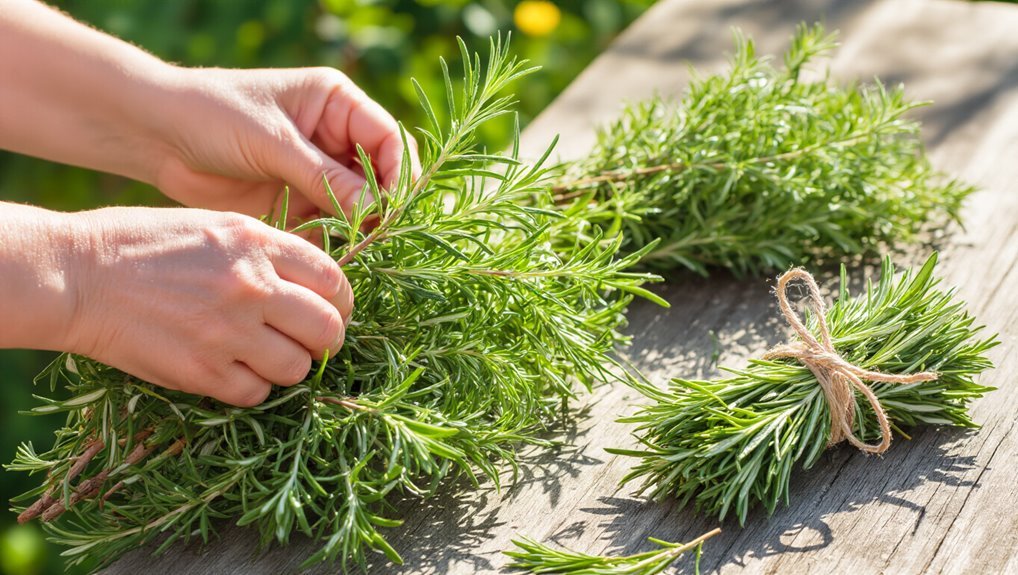
When you want to enjoy the robust flavor of rosemary long after the growing season ends, harvesting and preserving it for drying becomes essential. To do this effectively, follow these tips:
- Choose the Right Time: Harvest rosemary early in the morning when the oils are most concentrated. Look for healthy, vibrant stems.
- Cut Properly: Use sharp scissors to cut sprigs, leaving at least two-thirds of the plant intact. This encourages regrowth. For gardeners looking to further enrich their soil, outdoor composting systems can transform yard clippings and plant waste into beneficial compost.
- Drying Method: Bundle your sprigs and hang them upside down in a cool, dark place with good airflow. Alternatively, use a dehydrator or an oven on low heat.
For those interested in creating nutrient-rich soil for your garden herbs, consider using compost bins to recycle kitchen and garden waste into valuable compost. With these steps, you’ll have dried rosemary ready to enhance your dishes all year round!
Frequently Asked Questions
Can I Harvest Rosemary During Winter Months?
Yes, you can harvest rosemary during winter months, but be cautious. Cold temperatures may affect its flavor and growth. Ensure the plant is healthy, and only take what you need to encourage continued growth.
How Often Can I Harvest Rosemary?
You can harvest rosemary every few weeks, especially during the growing season. Just make sure not to take too much at once; leaving some for the plant helps it thrive and produces better flavor.
Is It Safe to Harvest Rosemary From My Garden?
When you stroll through your garden, the fragrant rosemary invites you closer. Yes, it’s safe to harvest. Just ensure your plants are healthy and free from pests, and you’ll enjoy fresh, aromatic leaves for your dishes.
Will Harvesting Rosemary Affect Its Growth?
Harvesting rosemary won’t negatively impact its growth if you do it properly. In fact, regular pruning encourages bushier growth and enhances the plant’s overall health. Just be sure to leave enough foliage for photosynthesis.
Can I Use Kitchen Scissors for Harvesting Rosemary?
Using kitchen scissors for harvesting rosemary is like using a trusty old knife for a fine meal; it works perfectly! Just make sure they’re clean, and you’ll have fresh sprigs ready for your culinary creations.
Conclusion
In summary, successfully securing your rosemary requires a bit of skill and timing. By trimming thoughtfully and tackling the task with the right tools, you’ll savor splendid sprigs for seasoning. Remember to store your fresh finds properly, so their flavor lasts longer. Whether you dry or delight in them fresh, your rosemary harvest can be a rewarding ritual. So, get ready to reap and relish the robust aroma and taste of your homegrown herbs!
